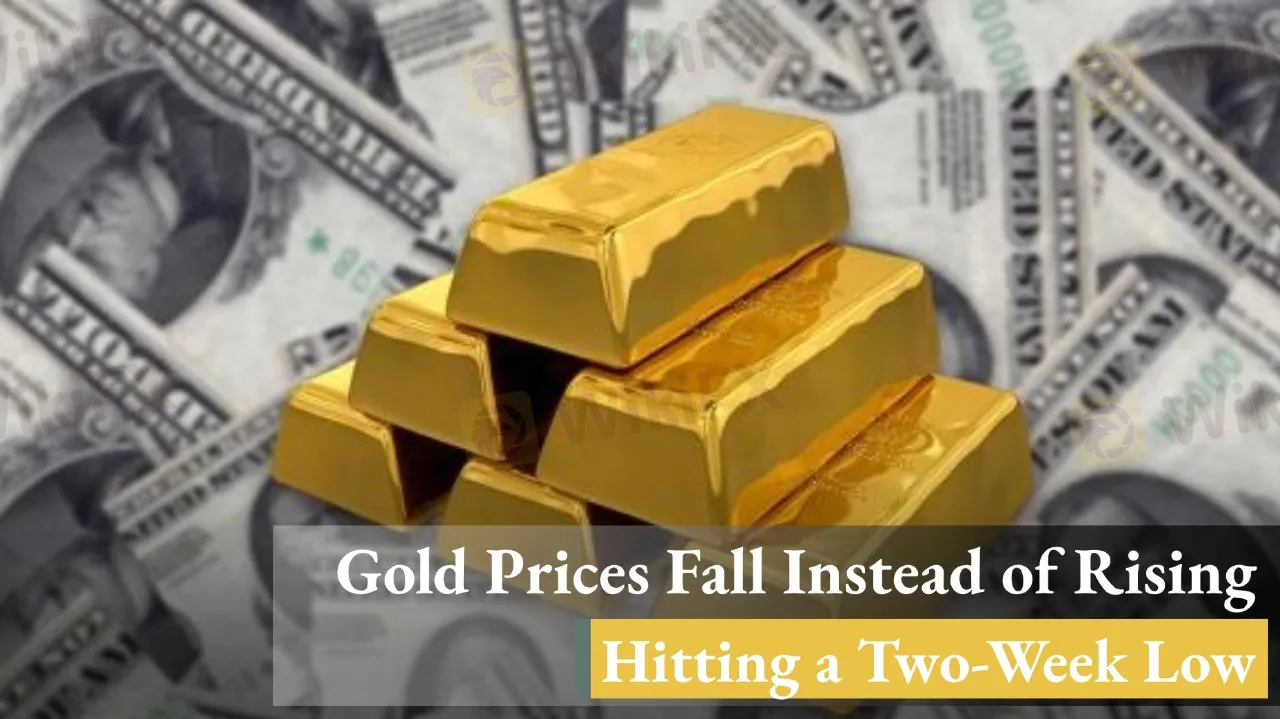简体中文
繁體中文
English
Pусский
日本語
ภาษาไทย
Tiếng Việt
Bahasa Indonesia
Español
हिन्दी
Filippiiniläinen
Français
Deutsch
Português
Türkçe
한국어
العربية
Gold Prices Fall Instead of Rising, Hitting a Two-Week Low
Abstract:Despite geopolitical tensions, gold prices have dropped sharply, reaching a two-week low. Markets refocus on Fed policy and broader macro trends.

Gold prices fell significantly this week. Spot gold closed at $3,368.68/oz on Friday, marking a 1.8% weekly decline and its lowest level since June 12. U.S. gold futures settled at $3,385.70/oz, down 0.7% for the week. Despite ongoing geopolitical uncertainty, gold failed to find traction, prompting investors to reassess their positions.
The recent downtrend reflects shifting market dynamics. Although gold initially appeared resilient, fading safe-haven demand and macro factors such as interest rate expectations and dollar strength ultimately dragged prices lower.
Why Are Gold Prices Falling?
Hawkish Fed Stance Pressures Gold
The Federal Reserve held rates steady this week, but the updated dot plot showed seven of 19 policymakers expect no rate cuts this year. This hawkish tone pushed the U.S. dollar higher, reducing the appeal of non-yielding assets like gold.
Geopolitical Risks Fail to Sustain Momentum
Although tensions in the Middle East remain, hints of de-escalation have reduced fear-driven buying. With the U.S. signaling it may delay involvement in regional conflicts, immediate demand for safe-haven assets has cooled.
Macro Fundamentals Weigh Heavily
Improved consumer sentiment and mixed leading indicators failed to spark fears of an imminent recession. Inflation concerns linger, but without a clear catalyst for risk aversion, investor appetite for gold has faded. Additionally, stronger U.S. economic data gave markets fewer reasons to bet on aggressive rate cuts.
Market Challenges Ahead
Uncertain Rate Cut Timeline
Despite softening inflation, the Feds mixed signals on future cuts have created confusion. If cuts are delayed further, it may dampen gold demand. Conversely, if cuts come quickly, it could spur a brief rally.
U.S. Dollar Strength
A strong dollar continues to cap gains for dollar-denominated commodities. If the dollar remains firm, gold may remain range-bound or trend lower.
Geopolitical Risk Remains Volatile
While conflict risk appears temporarily contained, any sudden escalation could reignite gold buying. However, market reactions have grown more measured, limiting upside potential.
Shift in Capital Flows
As investor sentiment leans toward risk assets like equities and high-yield debt, safe-haven demand for gold may decline further. Without sustained ETF inflows or central bank demand, golds support weakens.
Investor Challenges and Considerations
Timing the Market Becomes Tricky
Investors seeking to “buy the dip” must remain cautious, as policy shifts or geopolitical headlines could trigger unexpected volatility.
Managing Volatility
With price swings growing more frequent, position sizing and risk management become critical. Stop-loss orders and clear exit strategies are essential.
Diversification is Key
Relying solely on gold for risk protection is risky. Investors should consider complementing it with bonds, defensive equities, or foreign currencies like the yen.
Hedging Costs Rise
As interest rates stay elevated, using futures or options to hedge gold positions becomes more expensive. This erodes returns for leveraged investors.
Six Key Drivers of Gold Prices
1. Real Interest Rates (Nominal Rate - Inflation)
Lower real rates make gold more attractive since the opportunity cost of holding a non-yielding asset decreases. Rising real rates have the opposite effect.
2. U.S. Dollar Strength
Since gold is priced in dollars, a strong dollar makes gold more expensive in other currencies, suppressing global demand.
3. Inflation Expectations
Gold often acts as an inflation hedge. Rising inflation usually boosts gold demand. If inflation expectations ease, gold loses some of its appeal.
4. Geopolitical and Risk Sentiment
War, sanctions, or financial instability typically drive safe-haven flows into gold. But over time, markets may become desensitized to prolonged conflicts.
5. Central Bank and Institutional Buying
Recent years have seen consistent central bank gold purchases. If this trend reverses or pauses, gold could lose an important pillar of support.
6. Speculative Activity and Technical Levels
Traders often drive short-term gold movements. Key support/resistance levels, moving averages, and momentum indicators like RSI influence short-term trends. A break below $3,300 could spark further technical selling.
Gold remains a complex asset influenced by both macroeconomic and geopolitical factors. While its role as a safe haven endures, recent price action suggests investor conviction is wavering. With uncertainty ahead, strategic diversification and disciplined execution are more crucial than ever.

Disclaimer:
The views in this article only represent the author's personal views, and do not constitute investment advice on this platform. This platform does not guarantee the accuracy, completeness and timeliness of the information in the article, and will not be liable for any loss caused by the use of or reliance on the information in the article.
Read more

UnityFXLive: How This Broker Scammed Over $350,000 ? Know the Red Flags
On August 4, 2025 Indian police arrested two men for running a fake forex trading scam under the name UnityFXLive.com. The suspects were caught operating from a rented office in Goregaon, Mumbai. During questioning, they revealed the name of a third person who is believed to be the mastermind behind the scam. He is currently on the run. The scammers promised people high returns on forex investments, but instead of doing real trading, they stole the money using fake online platforms.

Clone Brokers vs. Real Brokers: How to Find Out
In the world of online trading and investing, one of the biggest threats to new and experienced traders alike is falling into the trap of clone brokers. These are fake or scam brokers who impersonate legitimate companies to trick investors. Understanding the difference between a clone broker and a real broker is essential for protecting your money and making smart financial decisions.

Should You Trust DeltaStock? Key Warning Signs to Consider
When you choose any broker to invest your money, do you also check whether any regulatory warnings have been issued against them? If not, it's important that you do. Otherwise, you may risk falling victim to a scam. We bring this up because DeltaStock appears to be actively offering its services in the market. However, several reputable authorities have issued warnings against this broker. Check out those warnings below and be Scam Alert.

Interactive Brokers Launches TipRanks Analytics, Forecast Contracts in Europe
Interactive Brokers boosts investing with TipRanks’ Smart Score, Trending Stocks tools, and Forecast Contracts for Europe. Get data-driven insights.
WikiFX Broker
Latest News
Forex Swaps Explained in 5 Minutes – Everything You Need to Know
Telegram vs WhatsApp vs Discord: Which Platform Is Best for Forex Signals?
Investment Scam Alert: FCA Identifies 15 Scam Brokers
BaFin Issues Consumer Alerts Against Unauthorised Platforms
Retired Man Loses Life Savings to ‘Sister Duo’ in Forex Scam
Exploring Laxmii Forex: Kharadi's Financial Hub
TradexMarkets: 5 Troubling Signs You Shouldn’t Ignore
A Guide to Buy Stop vs Buy Limit in Forex Trading
SEC Implements New Rules for Crypto-Asset Service Providers
Binance Users Convert Crypto and Withdraw Instantly to Mastercard
Currency Calculator


